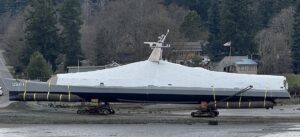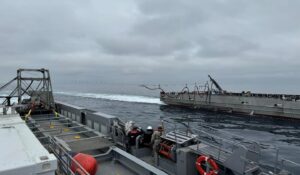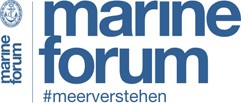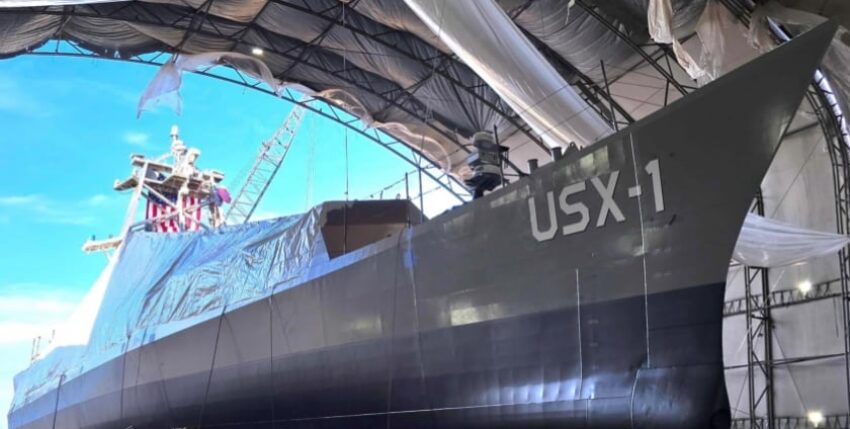With the Defiant, the prototype of a potentially armed, medium-sized unmanned surface vehicle is undergoing several months of sea trials this spring. In future, the boats will be able to perform a variety of different tasks autonomously.
USX-1 was developed on behalf of the Pentagon's technology agency, the Defense Advanced Research Projects Agency (Darpa). The programme is called Nomars, an acronym for No Manning Required Ship. The aim is to develop a ship that can operate at sea for long periods of time without a human crew.
"The Nomars programme deviates from the traditional shipbuilding model," explains Darpa. Although the US military already has a large number of autonomous ships and boats, the Nomars programme These fall into two superordinate groups: on the one hand, small boats and even smaller, raft-like surface vessels that are unsuitable for carrying a crew for extended periods; on the other hand, medium to larger units that are now suitable for "optionally unmanned" use by converting manned tenders, but still have the on-board infrastructure for a crew. Nomars, on the other hand, was designed from the ground up without facilities for a human presence on board.
This approach should bring various operational advantages. The ship can be smaller without sacrificing performance. Both the smaller size and the elimination of the equipment required for a crew reduce procurement and operating costs. The streamlined hull and optimised weight distribution reduce resistance in the water, resulting in high stability and efficient fuel consumption. The unit can also be equipped with better stability characteristics. Even damage limitation should benefit from the elimination of the crew. For example, in the event of a fire, a gas that is lethal to humans is automatically released, which displaces oxygen within the ship and immediately smothers the flames.
Development and testing
The Nomars programme was launched in 2020. In 2022, Darpa awarded the development contract worth 68 million dollars to Serco as the main contractor and system integrator. The Nichols Brothers shipyard near Seattle was commissioned to build the prototype.
The USX-1 DEFIANT prototype was completed in February 2025. So far, the Pentagon has not provided any official information regarding the whereabouts of the prototype, but according to observers in early March, the ship was taken to the nearby Whidbey Island naval base with the help of a tugboat.
Initially, the seaworthiness will be tested for two months at the pier and then at sea near the coast. If everything goes satisfactorily, "a very extensive and intensive demonstration of the ship and its capabilities will be carried out in the spring," explained the Serco programme manager responsible, Ryan Maatta. This intensive sea trial is estimated to last three months. It is focussed solely on the maritime capabilities of the vehicle; no weapons systems will be installed or tested on board. At the end of this trial phase, the prototype will be transferred from Darpa to the US Navy for further operational testing.
Deployment concept
The potential range of tasks includes long-range and long-term reconnaissance and surveillance as well as deployment as a weapon carrier. Logistics tasks, such as supplying troops or smaller ships in remote operational areas, are also being considered. "We will develop deployment and maintenance models to deploy large flotillas of unmanned surface vessels to partner the US Navy's larger manned warships around the globe," explained Gregory Avicola, the Darpa programme manager responsible.
With a length of 55 metres and a displacement of 240 tonnes, the DEFIANT of the Medium Unmanned Surface Vessel (MUSV) category. The elimination of the on-board infrastructure required for a crew results in a significantly larger payload capacity, including the provision of a large usable area on the upper deck. A main mast located amidships and a small mast located on the foredeck will accommodate various sensors including radar systems and communication antennas.

The Pentagon has so far remained silent regarding possible weaponisation. Only a general statement from Darpa that Nomars will carry "a significant payload with a tactically relevant range" has been published. During the Navy League exhibition in April 2024, the company Serco presented ship models that could carry the DEFIANT with a missile container on the foredeck and a standard container on the aft deck. The standard container contains various reconnaissance payloads, such as unmanned aerial vehicles, unmanned underwater vehicles, a towed sonar for submarine hunting or electronic warfare equipment.
The weapon carrier on the foredeck is a so-called Adaptable Deck Launcher (ADL) from BAE Systems. ADLs are designed to carry the same weapon systems that are carried in vertical launch cells on larger ships, including anti-ship missiles, cruise missiles to engage land targets, submarine-launched missiles and anti-aircraft missiles. Depending on the design, ADL containers can be equipped with two, four or eight payload cells.
Serco also presented a model of a larger variant during the Navy League conference. This has four ADL systems, each with four payload cells, i.e. a total of 16 missiles. Ryan Maatta explained that such a unit would be suitable as an escort ship for transport convoys.
Full autonomy
The unmanned surface vehicles would have to be refuelled at sea for longer missions. Serco developed for the DEFIANT its own refuelling equipment that works without direct human intervention on board. The process was tested at sea in September 2024. For this purpose, two former tenders, which had already been converted into MUSVs a few years ago, were equipped with the refuelling system developed for Nomars. Although personnel from the supply ship switched to the unmanned units to monitor the refuelling process, the actual fuel transfer was completely autonomous.
This comprised all steps including transferring the lines and hoses, connecting the hose coupling to the tank nozzles, returning the hoses and sealing the tank connections after the fuel transfer was completed. The next step is to test the refuelling process as part of the sea trials of the DEFIANTtested. Darpa emphasises that future operational use of Nomars will not require personnel to switch from the supply vessel to the unmanned ship; this should speed up the refuelling process and - especially in bad weather - reduce the risk to the tanker's crew.

The unmanned ship should be able to remain in operation for a year and reach a sustained speed of 15 knots. Critical operational systems are to be installed multiple times in order to ensure the ship's operation even if individual components fail. The ship's systems are modular so that maintenance and replacement can be carried out in the area of operation, even in a marina. The time-consuming return to the base or to a specialised shipyard is eliminated so that the unit can spend as much time as possible on patrol.
The aim of the Nomars programme is to introduce powerful unmanned units that can be produced cost-effectively in large numbers. The permanent deployment of a large number of scattered MUSVs is intended to enable the American fleet to neutralise even a numerically superior and militarily equal opponent.
A procurement decision is expected in 2027. According to Serco, the pure production costs of the prototype are around 25 million dollars. In series production, the unit costs are likely to be significantly lower. One reason for the comparatively low price is the simplified design. Instead of being built at specialised shipyards, Nomars units could also be built at small boatbuilding companies, such as the Nichols Brothers shipyard commissioned to build the prototype, in a converted factory building "or even in a disused marshalling yard", explained Ryan Maatta.
Sidney E. Dean










